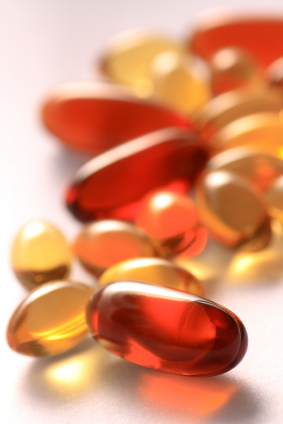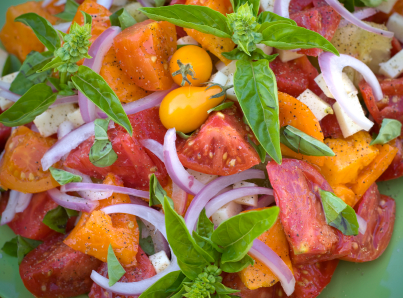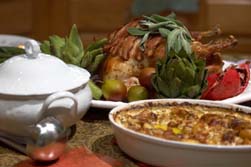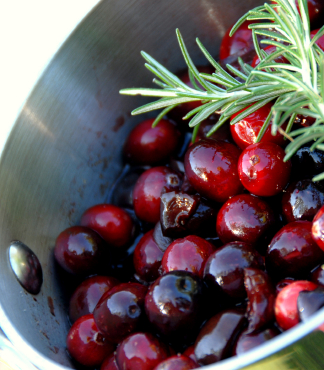Fall 2008: To Your Health
In this Issue:
- Fish Oil and Red Yeast Rice May Help Lower Blood Cholesterol
- Tea Drinking Associated with Increased Bone Mineral Density
- Have a Salad Plate as Colorful as Autumn’s Leaves
- 3 Great Ways to Fall into Fitness
- Be Wary of Gobbling Thanksgiving Calories
- Feature Food of the Month: Cranberries
- Healthy Recipe: Poached Pears in Cranberry Juice
Fish Oil and Red Yeast May Help Lower Blood Cholesterol

September is National Cholesterol Education Month
Too much cholesterol in the blood can lead to cardiovascular disease—America’s number one killer. The good news is that high cholesterol is reversible by taking responsibility and control of your own cholesterol levels. The National Cholesterol Education Program (NCEP) is sponsoring National Cholesterol Education month during September to help prevent and decrease the progression of cholesterol levels. Scientific evidence has shown that cholesterol-reducing medications, knows as statins, can help prevent heart disease by lowering blood cholesterol levels. Unfortunately, not all people are willing or able to take these medications.
According to the Mayo Clinic Proceedings, an alternative approach to treating high blood cholesterol may provide an effective treatment option. In a recent study, 74 individuals with high blood LDL (“bad”) cholesterol levels were randomly assigned to either a standard statin pill or a capsule containing red yeast rice extract and fish oil. In addition, the participants given the red yeast rice/fish oil capsules participated in a 12-week lifestyle program that involved weekly 3 ½ hour educational meetings led by a cardiologist, dietitian, exercise physiologist, and several alternative or relaxation practitioners. At the end of the 3 month period, they found that the alternative treatment group experienced a 42.4% drop in LDL levels, as compared to the statin group, whose LDL levels dropped by 39.6%. In addition, the alternative group experienced a drop in another blood lipid level (triglycerides) and a reduction in their weight. These results are very motivating and show that their may be a potential benefit to an alternative approach to a common medical condition.
Red yeast rice, also called hong qu, is a Chinese herb that is made by fermenting Monascus purpureus over red rice. It contains specific naturally occurring substances almost identical to those found in statin drugs. Fish oil has long been known to decrease blood triglyceride levels and act as an anti-inflammatory. A combination of lifestyle changes, such as a heart healthy diet, moderate physical activity on most days of the week for 30 minutes, and weight loss, with a supplement of fish oil, may help decrease high lipid levels without the need for medications. Red yeast rice extract comes in supplement form, however the FDA has banned lovastatin- containing red yeast rice since it contains a regulated substance. It is virtually impossible for a consumer to know whether or which red yeast rice products sold in the U.S still contain lovastatin. So for now, focus on the modifiable risk factors of heart disease by eating a healthy diet, being physically active, and avoiding smoking. Note: Always consult your physician before taking any herbal supplements.
Reference: Becker, D.J. et al. “Simvastatin vs. therapeutic lifestyle changes and supplements: randomized primary prevention trial.” Mayo Clinic Proceedings, 83(7): 758-764. 2008.
For information on the top 10 cholesterol-lowering foods, click here
Tea Drinking Associated with Increased Bone Mineral Density

October 20th is World Osteoporosis Day
Tea, an extract of the leaves of the Camellia sinensis, is commonly consumed throughout the world. In fact, after water, tea is the most common drink consumed regularly by most adults. Whether it’s black, green or red (oolong) tea, they all contain polyphenols, which give tea its antioxidant properties. Antioxidants may help decrease your risk of many diseases, such as cancer. Herbal teas are not derived from the same leaf as the green, black or red teas and therefore do not contain the beneficial antioxidants. Recently, tea has been found to have beneficial effects on bone density.
As you age, you lose some bone mass. Bones naturally become thinner as you grow older because the existing bone gets broken down faster than it is made. As this occurs, your bones lose calcium and other minerals, becoming lighter, less dense, and more porous. This makes the bones weaker and increases the chance that they may break.
A recent study in The American Journal of Clinical Nutrition, showed that women who were regular tea drinkers had a 2.8% higher bone density in two sites in the hip as compared with non-tea drinkers. Over a 4-year period, tea drinkers lost an average of 1.6% of their total hip bone mineral density, as compared to non-tea drinkers who lost 4%. Researchers are unsure of the exact component in the tea responsible for this cause, though phytochemicals, such as antioxidant flavanoids present in tea, have been suggested to be important. Overall, this data supports the concept that tea intake has a beneficial effect on bone density and reducing bone loss. If you’re not a tea drinker, should you start? Sure. In addition to tea’s possible role in preventing osteoporosis by increasing bone mineral density, it may help ward off cardiovascular disease and cancer. And while you’re at it, don’t be afraid to have a little milk (translation: calcium) in your tea.
What is the difference between the colors of the tea? The more processing tea leaves undergo, the darker they will turn. Green tea is the least processed tea. They are simply steamed quickly. Black and red teas are partially fried, crushed and fermented. Regardless of the processing methods, all these teas contain antioxidant properties.
Cooking with tea can be a great addition to creative main dishes, desserts, and sauces. It adds great taste and provides many health benefits! The easiest way to begin cooking with tea is by adding it to freshly made marinades and sauces for meat, fish, or poultry.
Reference: Devine A, et.al. “Tea drinking is associated with benefits on bone density in older women.” American Journal of Clinical Nutrition. 86(4): 1243-1247, 2007.
Click here for helpful tips and ideas for cooking with tea.
Have a Salad Plate as Colorful as Autumn’s Leaves

Consuming different colors of fruits and vegetables each day offers satisfying tastes, while increasing your protection against disease. The color molecules that form more than 2,000 pigments in plant foods contain strong antioxidants that can protect against heart disease and cancer, slow the aging process, and strengthen the immune system. The processed foods that you commonly eat cannot compare to the health benefits provided by a strawberry, which has fiber, vitamins, and minerals built right in. In general, the deeper the color of a fruit or vegetable, the more powerful it’s antioxidant action. The phrase “eating a rainbow” of fruits and vegetables was established as a simple reminder for you to get as much color variety as possible in your diet. Since each protects your body in its own unique way, the best way to power up your plate is to eat a variety of colors.
Red fruits and vegetables contain important nutrients and phytochemicals, like lycopene—a powerful antioxidant that helps protect against prostate and other cancers (cooked tomatoes have more lycopene than fresh ones). Anthocyanins—found in red-skinned apples, radishes, cherries, and beets—decrease heart disease risk, lower blood pressure, and help stop inflammation. Ellagic acid, found in berries and pomegranates, help prevent cancers. Resveratrol, an antioxidant found in red and purple grapes and juices, may help decrease the risk of heart disease and stroke.
Orange and Yellow fruits and vegetables help maintain heart, vision, and immune system health, and lowers the risk of some cancers. Many of the fruits and vegetables in this group are high in vitamin C and folic acid. Orange and some yellow vegetables—such as yellow peppers and corn—contain high amounts of the pigment lutein, which helps maintain vision. Carrots, peaches, mangos, lemons, grapefruits, and apricots are just a few examples of great cancer fighting foods.
Green fruits and vegetables contain chlorophyll, which gives these foods their green pigment. Glutathione, an antioxidant found in asparagus, avocados, spinach, and broccoli, help protect DNA and RNA from oxidative stress and help strengthen the immune system. Folate, a B vitamin, found in dark green leafy vegetables, helps reduce the risk of heart disease and helps prevent birth defects. Iron, vitamin k, magnesium and calcium help keep bones and teeth strong, while promoting healthy blood.
Blue and Purple fruits and vegetables contain nutrients similar to those of the green category. Blue pigment, anthocyanin, is high in bilberries and blueberries, and has been shown to protect against age-related memory loss. Blueberries and cranberries help protect against bladder infections and possible ulcers and gum diseases. Tannins are substances found in berries that are known for preventing harmful bacteria from attaching to our cells and organs.
White/Tan/Brown fruits and vegetables contain few bright pigments, though these vegetables make up for their lack in color with a strong taste that comes from sulfur compounds that protect DNA, help lower cholesterol, and maintain a healthy immune system. Saponins, found in onions and garlic, help stimulate the immune system and lower the amount of fats circulating around the bloodstream. Pears and mushrooms contain antioxidants that protect the cell membranes in the body. Isoflavone phytochemicals—found in dried beans, peanuts, lentils, soy, and other legumes—help reduce the risk of heart disease and colon, prostate, and stomach cancers.
For ideas on decorating your plate with fruits and vegetables of the rainbow, click here.
3 Great Ways to Fall into Fitness

The end of summer can be slightly traumatic for some people, but not to worry because fall is right around the corner. With the kids back to school and the holidays on the way, it may seem impossible to find time to exercise, especially when the days seem to be getting shorter and the weather gets nippy. But, this is the best time of the year to get outside and enjoy the crisp, fresh air without all that humidity and heat.
Hiking: Fall is a great time to go hiking- the weather is cooler, fewer bugs, and of course, the changing of the leaves are beautiful! In addition, hiking burns more calories as you increase your elevation and really works those legs. The American Hiking Association states that hiking can reverse or slow down the progression of heart disease, decrease hypertension by expanding blood vessels, decrease cholesterol levels while increasing the “good” cholesterol, decrease weight by burning more calories, and prevent the ageing of the immune system. In addition, hiking can improve osteoporosis by improving bone density. A new e-tool from Google Earth plots hiking trails almost anywhere. Click the Layers list to reveal Featured Content—pick the Trimble Outdoors Trips finder, then type in the city. You’ll get coordinates, directions and video and/or audio clips for local paths to download to your cell phone or GPS device. So its time to buy a good pair of hiking shoes and think about a new sport!
Walking: Walking is one of the easiest forms of exercise. Grab yourself some comfortable shoes and get out there! Treadmills won’t challenge your body in the same way that walking on a sidewalk or trail will. The gym cannot give you curbs and uneven surfaces to work with. All of those little things do add up. The recent guidelines for walking is 10,000 steps per day. How far is 10,000 steps? The average person’s stride length is about 2.5 feet long. That means it takes just over 2,000 steps to walk one mile, and 10,000 steps is close to 5 miles. A sedentary person may only walk about 1,000 to 3,000 steps a day. Try increasing your average daily steps each week by 500 steps per day, until you can easily average 10,000 per day. If you need a little more motivation to get out there, pop a pedometer onto the waist of your pants and watch your steps increase as your weight decreases!
Running: Fall is probably the best time to go for a run outdoors. Its also one of the more accessible activities—all you really need is a good pair of running shoes and a place to run. But, even though its accessible, it takes time to build up your endurance, even for a short period of time. Start by walking for 10 minutes and running for 2 minutes. Each week, increase the amount of time you run, while decreasing your walking time. Running is a great way to get in shape, burn lots of calories, make your heart healthy, and increase bone density. Be consistent and you never know where your running may take you—you may be ready for your first marathon!
Reference: “Exercise and Fitness.” American Heart Association. 05 August 2008.
Click here for tips to guide you successfully through your fitness routine!
Be Wary of Gobbling Thanksgiving Calories

Did you know that the typical Thanksgiving dinner ranges from 2000-4500 calories, depending on what you put on your plate. It can be a real challenge if you’re watching your waistline. However, there is still lots of potential for making Thanksgiving dinner lighter and much healthier.
Healthy holiday eating tips:
- Don’t go to the Thanksgiving dinner hungry: One often eats faster and more when he is hungry. Therefore, eat a wholesome breakfast and lunch during the day to avoid overeating at dinner time.
- Thanksgiving dinner is not an all-you-can-eat buffet: Fill your plate half with vegetables, one quarter with a lean meat and the rest with a starch of your choice. Eat slowly and stop when you are full.
- Turkey —go skinless: Choose your turkey without skin to slash most of the fat!
- Make a conscious choice to limit high fat items: High fat food items can be found in fried and creamy dishes as well as cheese-filled casseroles in a traditional Thanksgiving meal. For instance, mashed potatoes are usually made with butter and milk; green bean casseroles are often prepared with cream of mushroom soup, cheese and milk topped with fried onions; candied yams are loaded with cream, sugar and marshmallows. If you cannot control the ingredients that go into a dish, simply limit yourself to a smaller portion.
- Drink plenty of water: Alcohol and coffee can dehydrate your body. Drink water to help fill up your stomach and keep you hydrated.
Save calories when sitting at the dinner table with these suggestions:
- Skip the roll and save 150 calories
- Hold the butter and save 185 calories
- Replace the sweet potato casserole with a plain baked sweet potato and save 280 calories
- Skip snacking on chips and save 150 calories per serving
- Skip nibbling on just 2 cookies and save 240 calories
- Skip the butter on your veggies and steam them to save 185 calories
- Replace the cranberry sauce with fresh cranberries and save 370 calories
Click here for holiday baking substitutions and ways to lower the calories and fat at your holiday meals.
Feature Food of the Month: Cranberries

You probably know cranberry sauce as a staple at the holiday table, but cranberries are a super food that you should enjoy all year round. The cranberry, cousin to the blueberry, is a tart, bright red berry long known for its ability to prevent and treat urinary tract infections. Fresh cranberries, which contain the highest levels of beneficial nutrients, are at their peak from October through December, just in time to add their festive, tart tangy flavor and numerous health protective effects to your holiday meals.
Cranberries offer many health benefits:
- Helps prevent urinary tract infections; not cure them! Consuming 8 to 10 ounces (about one cup) of 27% cranberry juice daily is enough to help prevent infection-causing-bacteria from sticking to the urinary tract wall.
- May help prevent atherosclerosis (plaque buildup in our arteries) that can lead to cardiovascular disease.
- Contains high anti-oxidants properties. One cup of whole cranberries has 8,983 total antioxidants capacity. Only blueberries can top that!
- Ongoing research suggests that cranberries may help prevent the development of some ulcers and mouth diseases.
To get the maximum usage of your fresh cranberries, store them in a tightly sealed bag in the refrigerator for up to 2 months. Try to pull out the soft ones because once one gets soft, the others follow soon. Picking the best berries will allow you to enjoy its wonderful taste. Truly fresh cranberries will bounce if you drop them. They are firm, shiny, and plump, ranging in color from light red to dark red. Berries with brown spots should be avoided.
Cranberries can be incorporated into your daily diet in a number of ways. Adding dried cranberries to your favorite cereal can give it a nice tangy taste and boost your breakfast’s antioxidant power. You can sneak cranberries into blueberry muffins for added color and flavor, plus you got yourself a super powered muffin! In addition, you can also pair cranberries with chicken and pork dishes for a delightful flavor.
Healthy Recipe – Poached Pears in Cranberry Juice
Ingredients:
1 ½ c. fresh cranberries, rinsed and picked over
2 c. apple juice (no sugar added)
1 Tbsp. honey
4 large firm almost ripe Bartlett or d’Anjou pears (about 2 lb.), halved, cored, and peeled
¼ tsp. cinnamon
1/8 tsp. ground cardamom or nutmeg
2 packets sugar substitute
¼ tsp. almond extract
Instructions:
- Put cranberries and apple juice in a 3 quart heavy bottom saucepan. Bring to a boil. Reduce heat to simmering. Cover and cook until all the berries pop (about 7 minutes).
- In a bowl, press out juices with a large spoon.
- Stir honey into juices. Discard solids.
- Arrange pears in layers in saucepan, rounded sides down. Cover with cranberry liquid. Bring to a boil. Reduce heat to simmering. Cover and simmer until firm-tender (about 10 minutes).
- Sprinkle with spices. Gently spoon liquid over pears. Uncover and let stand for 10 minutes.
- With a slotted spoon, transfer pears to a 3 quart covered bowl.
- Add sugar substitute to juices, stirring until dissolved, then pour over fruit.
- Cover and refrigerate several hours (or overnight) to permit flavors to develop fully.
Yield: 8 servings
Serving Size: ½ pear
Exchanges: 2 fruit
Nutrition Facts:
Calories: 109 kcal
Total Fat: 1 gram
Saturated fat: 0 grams
Cholesterol: 0 milligram
Protein: 1 gram
Carbohydrate: 27 grams
Sodium: 2 milligrams
Dietary Fiber: 4 grams
For more healthy recipes, click here.

Leave a Reply
Want to join the discussion?Feel free to contribute!